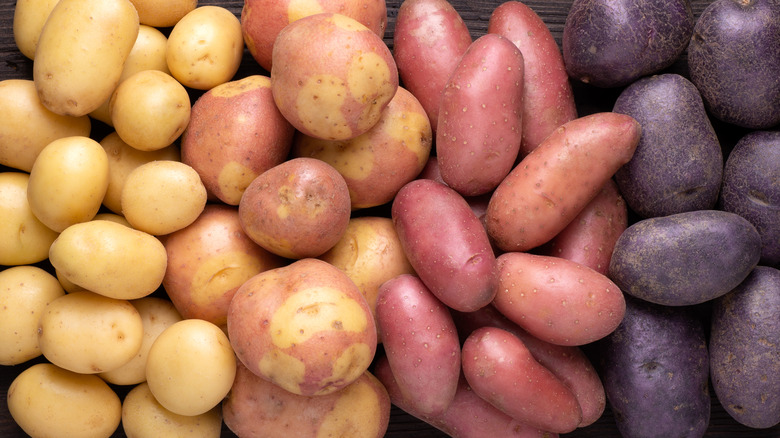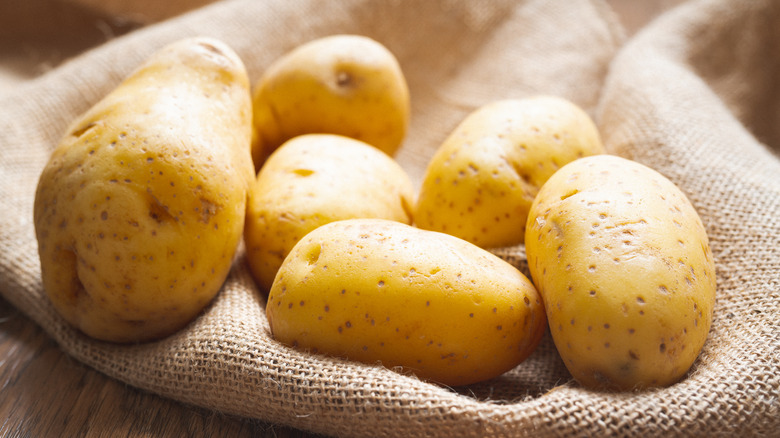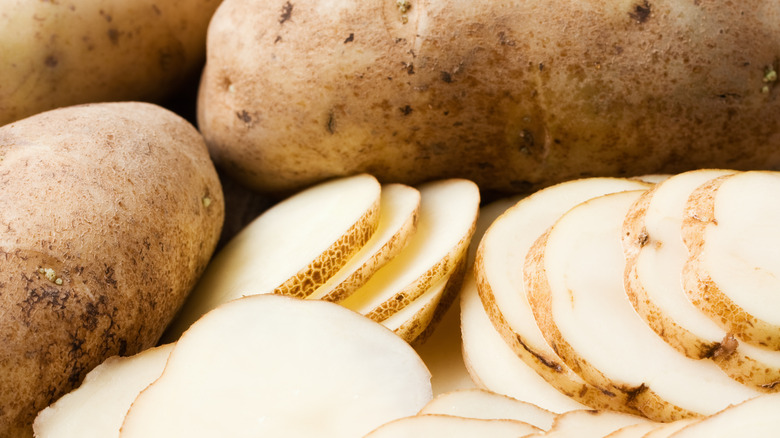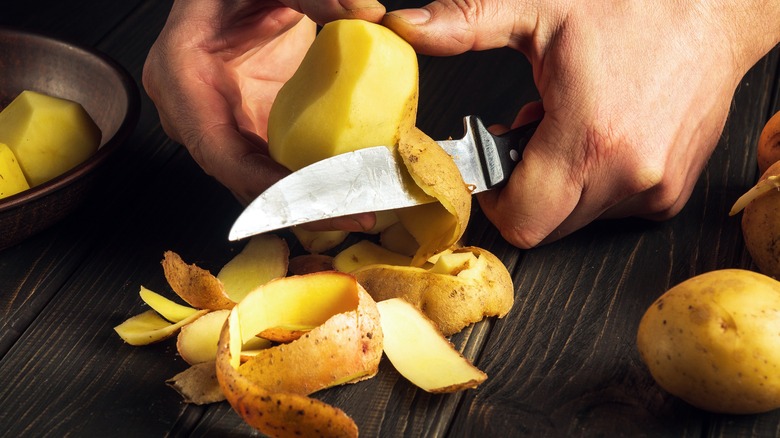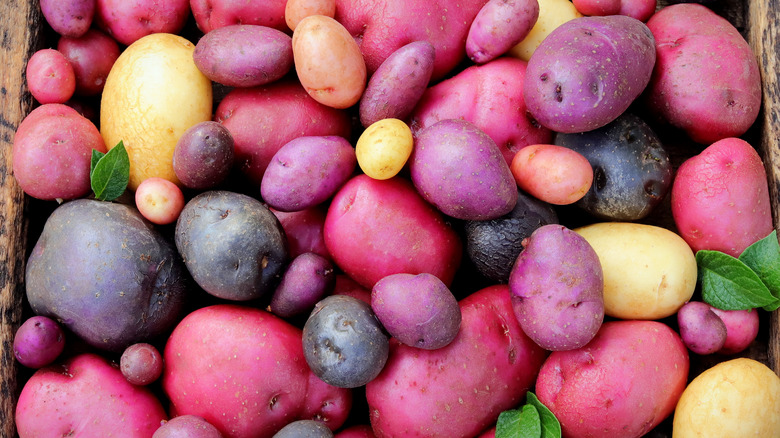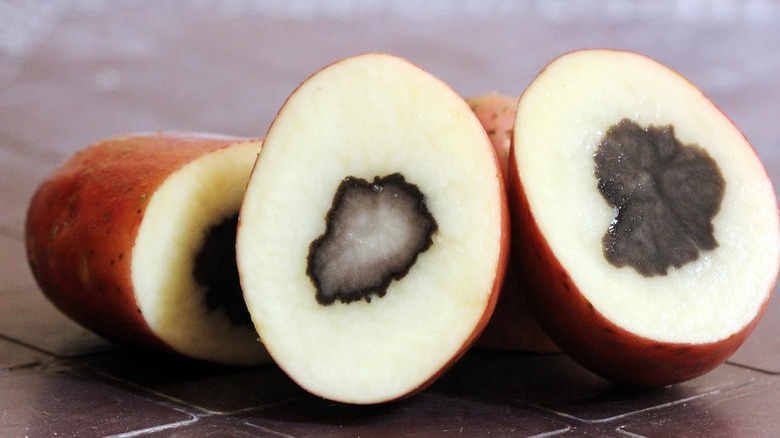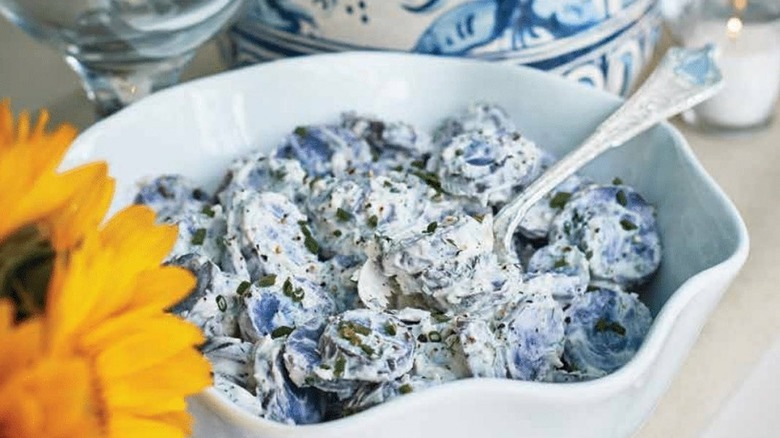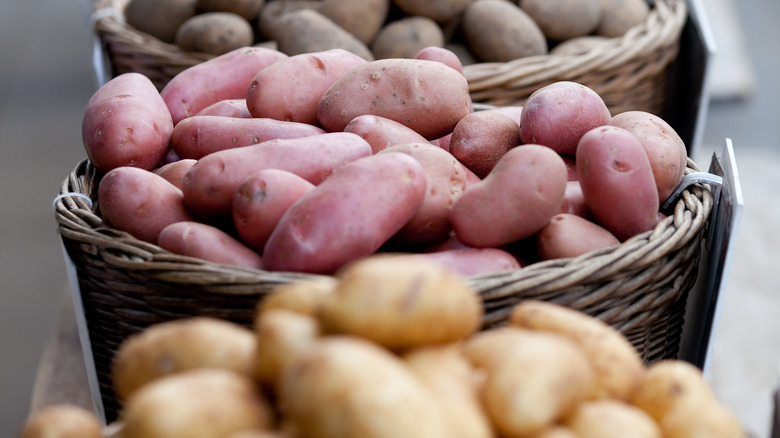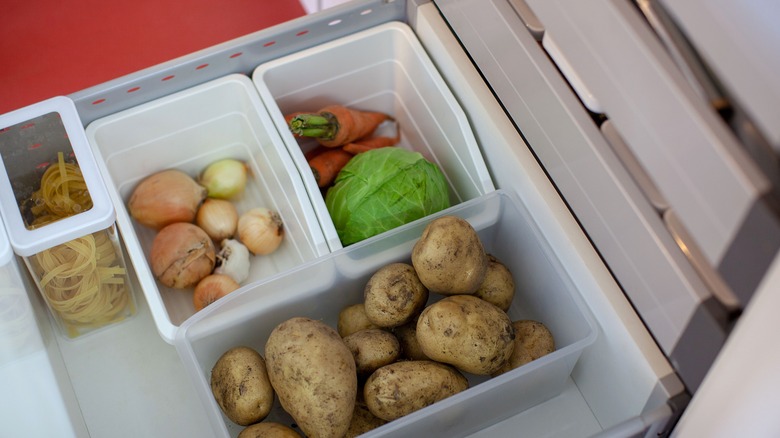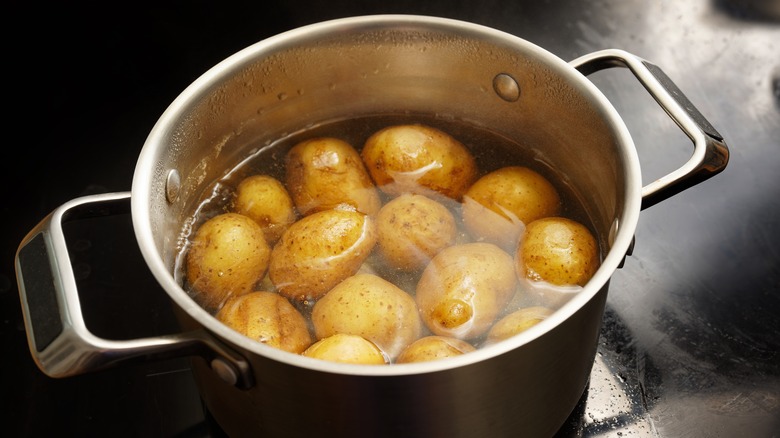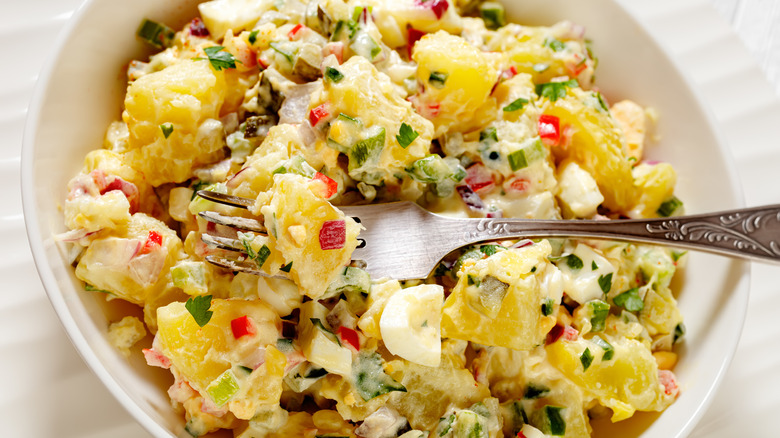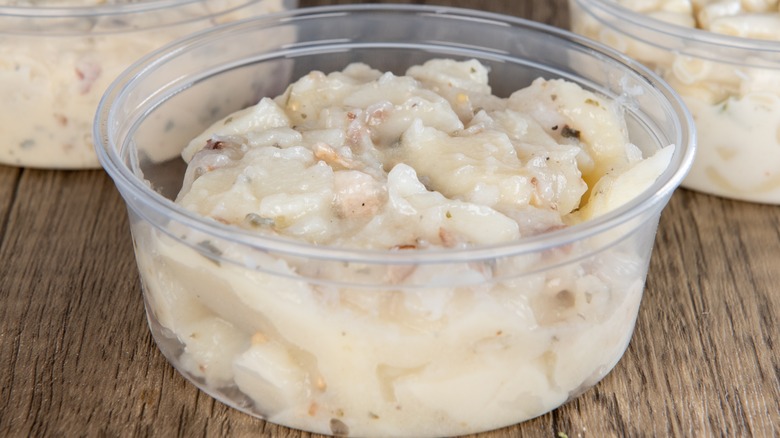How To Pick The Perfect Potatoes For Your Potato Salad Recipe
Potato salad may just be the best side dish ever created. It's cool and creamy. Depending on your ingredients, it can have a tart, acidic tang, or an earthy, savory umami quality. It's a classic comfort food we all grew up with, yet it's still easy to tweak and modify, making working with new ingredients or flavors a breeze. It goes with everything from backyard barbecues and burgers in diners to holiday potlucks — you can even add bacon and eggs and serve it at brunch! And even better than all that versatility, it's also super easy to make — with or without a recipe to follow — meaning it's an ideal food to prepare for home cooks of all experience levels.
To make any basic potato salad, you essentially just need to boil and cool some bite-sized potato chunks and then pair those potatoes with ingredients like hard-boiled eggs, chopped celery, and onion. Then mix everything you've added to your bowl with a dressing made from some combination of mayonnaise, mustard, vinegar, salt, and pepper. What could be easier?
Still, even classic and easy-to-prepare dishes can have issues from time to time, and potato salad is no different. In fact, the most significant factor in determining the success of your potato salad isn't even your technique or recipe. It's the potatoes you use. Some potatoes naturally make a great ingredient for potato salad, while others fail miserably. Here's how to pick the perfect potatoes for your next potato salad recipe.
Choose potatoes that are best for boiling
Potato salads all start the same way. You grab whatever potatoes you want to use for the salad, wash them, peel them — unless you are making a potato salad that includes skin-on potatoes — and then cut them into bite-sized chunks. Next, boil the potato pieces in salted water until the spuds are fork-tender but firm enough to hold their shape. Once that's done, drain your potatoes, let them cool, and then make your salad. The whole shebang should take about 15 minutes.
The caveat to this whole process? You need to start your potato salad with potatoes that hold up well in boiling water. That means you want to use what chefs call a "waxy" or "all-purpose" potato. Essentially, this means the potatoes are low in starch and pack more moisture. Once cooked, they will have a creamier, firmer texture than other potatoes. So, what potatoes fit the bill? New potatoes (or freshly harvested young potatoes) are an excellent choice since they tend to get starchier the larger they grow. Red potatoes have a naturally sweet flavor and a bright red peel and are another excellent choice. You could also opt for Yukon Gold potatoes, which are versatile and have a super creamy texture that's ideal for potato salad. Or, consider multi-color fingerling potatoes, especially if you intend to leave the peel on for the potato salad you have planned.
Avoid starchy potatoes
While red, Yukon Gold, new potatoes, and fingerling potatoes are all ideal options for making a potato salad, there are some potatoes you should also avoid when making up your shopping list.
Chief among the potatoes to skip when shopping for potato salad ingredients is the beloved russet. While russets may be a favorite for making mashed potatoes, baked potatoes, or even something out of the box like a potato waffle (try them; they're delicious!), they tend to break apart more easily during boiling — making them less than ideal for potato salads. If the bag of potatoes in your pantry simply says "Idaho potatoes," you'll need to do a bit of extra digging to find out exactly what kind of potatoes you have. Idaho potatoes can include several different varieties. To get that name, they simply have to be grown somewhere within the state. They aren't, however, a distinct potato variety on their own.
If you've only got russet potatoes on hand and don't have time to go to the store to buy something else, you can still make your potato salad. Just do whatever you can to help those spuds hold their shape. Use smaller potatoes first, if possible, versus larger ones. They'll hold their shape better. Starting your potatoes in cold water and bringing that water to a boil gradually — and adding a generous amount of salt to the water — can also help to prevent russets from falling apart as they cook.
Pick potatoes that will peel easily
Yukon Gold and red potatoes are great potato salad options because of their waxiness and lower starch content. But they're also an excellent pick for the job because they're some of the easiest to peel potatoes in most markets. Their skins tend to be relatively thin and delicate, making them much easier to prep when starting any potato salad recipe.
In addition to picking the right potato variety, if you want to keep your peeling as easy as possible, look for potatoes with a uniform, regular shape. The more oddly formed the potato, the longer it will take to peel. Smaller potatoes are also often easier to peel than larger ones. Finally, stick with fresh potatoes for your potato salad whenever you can, versus something that may have been in your pantry for a bit. The skin on fresher potatoes tends to be the easiest to peel, while older potatoes can develop thicker, tougher skin that is more challenging to remove.
For a quick, no-hassle peeling session, stick to a good-quality vegetable peeler or a paring knife with a sharp blade — anything else will make the task more of a chore. Clean, freshly washed potatoes also tend to be easier to peel. And if you're using a cutting board, trim a small slice from both ends of the potato first. This flat surface makes the potato easier to stabilize while peeling.
Make sure your potatoes are similarly sized
Opting for small yet similar sized spuds for your potato salad can make peeling away unwanted skins a breeze. But there are other reasons to focus on potato uniformity when making any potato salad as well. The biggest benefit you get from making potato salad with potatoes of the same size is that it leads to more uniform cooking. Potatoes of the same size tend to cook at the same rate. This is true whether you are boiling or baking your potatoes. Besides making meal prep more convenient, it also ensures that all the potatoes in your salad are perfectly cooked, neither undercooked nor overcooked.
Potato salads that are made with uniform-sized potatoes also tend to look more professional. The potatoes hold their shape better, which is great for impressing your dinner guests — and for posting on Instagram. And if you're not interested in appearances, uniformly sized potatoes will also help your potato salad taste better, with a more consistent texture and balanced flavor.
And don't worry. Once you cherry-pick all the good medium-sized potatoes, there are still plenty of things you can do with your "rejects." Small potatoes are ideal for cooking in an instant pot or air fryer. Similarly, large potatoes are wonderful baked — just wrap them with aluminum foil and cook until soft. Or use them diced up in everything from Crispy Hasselback potatoes to light and fluffy Potato Gnocchi.
Check your potatoes for freshness and bruising
When you have berries or bananas that have gone bad, it's immediately obvious the fruit is rotten. The same can't always be said with potatoes. It takes a bit of extra work and investigation to be sure you're cooking with the freshest potatoes available. Start checking the freshness of your potatoes by quickly inspecting the skin. It should be smooth, firm, and blemish-free. Fresh potatoes should have no cuts, bruises, or dark spots on the surface. Next, check for sprouts. These tiny growths may seem harmless — it's just the potato doing its thing and attempting to grow after all. Still, they also indicate that the potato is older and may have started to lose its freshness.
Next, feel the firmness of the potato. Gently squeeze it from both side to side and end to end. Fresh potatoes should feel firm to the touch. Soft or spongy spots can indicate decay. While feeling around the potato, check for mold, green spots, or sliminess. All are also clear indicators that the potato is past its prime. Take a second to take a whiff of the potato as well. Fresh potatoes have a neutral, earthy scent. If you notice any unusual or foul odors, it may be a sign of rot or spoilage. Finally, as you slice into the potato and begin to dice it up, look out for brown or black spots that may also be hidden inside.
Don't be afraid to experiment with different colored potatoes
While most potato salad you've tried in the past was likely made with some type of white-fleshed potato, any salad you make at home doesn't have to follow those constraints. For something truly eye-catching and tasty, you may want to make a potato salad starring purple, blue, or even vibrant orange potatoes. They may be hard to find in stores, but look around — farmer's markets are another great option for these rare but delightful spuds.
Blue and purple potato varieties to look for include the savory Adirondack Blue, the Blue Tomcat, the rich purple Magic Molly, the Peruvian Purple, and the Purple Majesty. If you can't locate them in your area, consider growing them in your garden. All have unique and exceptional flavors with minor variations over traditional white-fleshed potatoes. And you can use them in your potato salads in much the same way as any other potato — just peel, dice, and boil. (Just be careful dumping out that water — just as with beets, the purple color from the potatoes may stain light-colored fabric.)
Wondering about the orange potatoes we mentioned? That would, of course, be the sweet potato. And while it's not a traditional potato salad ingredient because of its high sugar content, you can make incredible potato salad with sweet potatoes. Add elements like bacon, celery, and onions, but use a tart mustard-based dressing instead of regular mayo to minimize that sweetness.
Buy potatoes that are in season
While it may not seem as important to buy fresh and in season as other produce, fresh potatoes that have been recently harvested will always yield the best tasting potato salad. Here in the U.S., you'll most likely find freshly harvested potatoes between late spring and early fall. New potatoes — those delicious young tubers with a thin skin and delicate flavor we already told you make an excellent choice for potato salad — are most abundant between late spring and early summer.
Yukon Gold potatoes are available year-round but tend to be harvested in late summer and early fall. Fingerling potatoes and purple and blue potatoes share the same seasonality, too. Visit a farmer's market and see what local merchants have for sale. Take advantage of them during this period for the absolute best buttery flavor and creamy texture. Regardless of the time of year or current growing season, the potatoes available in your grocery store have likely been in storage for quite a while and will not be as fresh.
If you can't find fresh potatoes or you are shopping for them in the winter months, don't worry. Grocers have developed high-tech temperature and humidity-controlled facilities to preserve maximum freshness, so your potatoes will still taste great. Just maybe not quite as special as if you are buying them locally from the farmer who actually grew them.
Store your potatoes properly until you use them
The quest for perfect salad-ready potatoes doesn't end once you leave the market. Once you have your spuds in hand, you need to protect them and store them properly until you have time to use them.
In a home setting, potatoes will typically last for one to two months before going bad. But to maximize potato shelf life, you need to store them somewhere that is cool, dry, dark, and well-ventilated. (And that is definitely not under your sink!) Dry basements are a great option. You want somewhere as cool as possible, ideally 45 to 50 degrees Fahrenheit. While you shouldn't store your potatoes in your fridge — it's way too cold — you may want to stash them in a wine fridge if you have one that has space to fill. Wine refrigerators closely mimic the temperature of a cool cellar and can be a great spot for produce to live until you use it up.
Don't wash your potatoes until just before using them. They'll keep better if they are perfectly dry and haven't been exposed to any unnecessary moisture. Also, keep the potatoes you are storing away from apples and onions — both release gases that promote premature spoilage. Finally, remove the potatoes from their plastic bag and put them somewhere with good ventilation — a slotted container or basket is a great storage option. Proper ventilation prevents the buildup of moisture, which can lead to rot.
Don't overcook your potatoes when prepping your salad
Once "potato salad day" arrives and you're ready to whip up your creamy, savory creation, take a few simple precautions to cook your potatoes to perfection. If you're making a rustic, skin-on potato salad, your easiest option will be to boil your potatoes whole until they are tender. This will take a bit longer, but it is the best way to keep your potatoes firm and prevent them from crumbling or falling apart as they cook. Let your cooked potatoes cool until you can handle them, and then dice them into small, bite-sized chunks.
For skin-free potato salad, first put a pot of water on to heat. Add one to two tablespoons of salt and bring the water to a gentle boil. Then add your diced potatoes, being careful not to overcrowd the pot. Once your water begins to boil, cover the pot and reduce the temp to maintain a gentle simmer. Let your potatoes cook for 10 to 15 minutes, checking their doneness frequently to avoid overcooking. The potatoes are done when they are tender but still hold their shape.
Once your potatoes seem tender and ready, immediately drain them in a colander. Don't leave them in hot water, though — if you do, the residual heat may still lead to overcooking. Instead, spread the drained potatoes on a baking sheet in a single layer to further halt the cooking process and speed cooling.
Mix your potato salad carefully (so you don't end up with potato mush)
Boiled, diced potatoes are inherently crumbly. If you're not careful, they're just a few brisk stirs away from turning into a bowl of mashed potato mush. To keep this from happening when you make your potato salad, it's essential to ensure that all of your ingredients — especially your cooked potatoes — have had some time to chill in the fridge. The colder cooked potatoes are, the better they hold their texture while you make your potato salad.
When it comes time to stir your ingredients together, ensure you follow the correct order of components. Start by adding your dressing and any herbs or spices you might be using to the bottom of your bowl. On top of that dressing, pile in your other ingredients like chopped onions, celery, pickles, crumbled bacon, or diced hard-boiled eggs. Finally, spread your potatoes on top of all of those other foods — they should be the last thing you add to the bowl.
Then, instead of just stirring your ingredients together, try to "lift and fold." Using a spatula or large wooden spoon, gently lift and fold the potatoes and other ingredients together with the dressing. Your folding motion should start from the bottom of the bowl and bring the ingredients on top down. Avoid stirring in a circular motion — this will inadvertently mash the potatoes. Once everything is evenly combined, the salad is ready to serve.
Finally, store your potato salad for maximum freshness
Congratulations! Your Yukon Gold or purple fingerling potato salad with creamy mayo, peas, corn, and bacon crumbles was a huge success. You picked the right potatoes, and everybody loved the dish. To make the most of any leftovers you might have, your last mission is to store that potato salad in a way that preserves maximum freshness. For starters, remember Grandma's warning from when you were a kid and don't let the potato salad sit out for an extended period at room temperature. In addition to promoting the growth of bacteria, your potatoes will be more likely to start breaking down and losing their shape the longer they are exposed to room-temperature air.
While you can't freeze leftover potato salad — it just turns to mush — you should keep your leftovers in the salad crisper or the coolest part of your fridge. Store your extra potato salad in an airtight container with a tight-fitting lid. If the container isn't full, place plastic wrap or parchment paper directly on the surface of the potato salad before you close the container. This minimizes contact with air, which can cause your potatoes to brown. Plan to use up any leftovers within three to four days, max. Any longer, and the ingredients in your potato salad may begin to lose quality or flavor. Happy cooking. We wish you a 'spud-tacular' feast!
